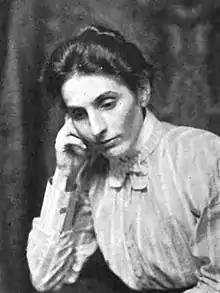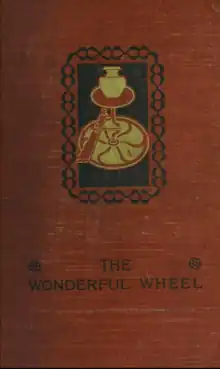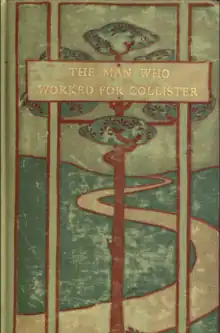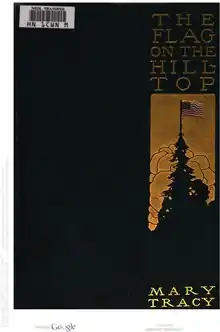Mary Tracy Earle
Mary Tracy Earle (October 21, 1864 – September 7, 1955) was an American fiction writer.[1] She contributed short stories and occasional essays to various periodicals. Among her published works can be counted The Wonderful Wheel (1896), The Man Who Worked for Collister (1898), Through Old Rose Glasses (1900), and The Flag on the Hilltop (1902).
Mary Tracy Earle | |
|---|---|
 | |
| Born | October 21, 1864 Cobden, Illinois, U.S. |
| Died | September 7, 1955 (aged 90) Riverside, California, U.S. |
| Occupation | Author |
| Alma mater | University of Illinois |
| Spouse |
William Titus Horne
(m. 1862; died 1944) |
| Relatives |
|
| Signature | |
Early life and education




Mary Tracy Earle was born in Cobden, Illinois, October 21, 1864. Her parents were Parker and Melanie (Tracy) Earle.[2][3] Parker was the horticultural director at the World Cotton Centennial in New Orleans, 1884.[4] Melanie's mother, Hannah Tracy Cutler was an abolitionist as well as a leader of the temperance and women's suffrage movements in the United States. Mary had two brothers: Charles Theodore Earle, and the mycologist, Franklin Sumner Earle.[5][6]
Earle attended Cobden High School. She represented Alethenai Literary Society in the intersociety oratorical contest of 1884,[3] while attending the University of Illinois. She graduated from the University of Illinois in 1885 (B.S.) and received an A.M. degree in 1903.[2]
Career
Beginning in 1885, Earle lived in the south, where she began to write, at first not with any purpose, but simply in accordance to the inspiration. As she grew older, her predilection for literary pursuits became more pronounced, and in 1898, when she removed to New York City, it was with the intention of devoting herself seriously to a writing career.[7] She continued writing through 1904. From 1904 to 1907, she served as a Librarian and Editorial Assistant, Estación Central Agronómica de Cuba. In 1907, she returned to writing.[3]
On July 1, 1906, in Santiago de las Vegas, Cuba, she married William Titus Horne (1876-1944), Professor of Plant Pathology in the University of California, Berkeley.[2][3][5]
From 1887, Earle contributed short stories and occasional essays in The Outlook, The Atlantic Monthly, The Century, Everybody's, Harper's Weekly, McClure's, Scribner's, as well as other magazines and papers. She was also the author of: The Wonderful Wheel (Century Company, 1896); The Man Who Worked for Collister (Copeland & Day, Boston, 1898); Through Old Rose Glasses (Houghton, Mifflin & Co., Boston, 1900); and The Flag on the Hilltop (Houghton, Mifflin & Co., Boston, 1902).[3] Most of her stories were of the South, where she had spent much of her time, but some are of Southern Illinois.[2]
Personal life
In 1907, Earle was living in Santiago de las Vegas, Cuba.[2] In 1913, she was living in Berkeley, California.[8][3] She died in Riverside, California, September 7, 1955.[9]
Selected works
- The Wonderful Wheel, 1896
- The Man Who Worked for Collister, 1898
- Through Old Rose Glasses, 1900
- The Flag on the Hilltop, 1902
References
- Beach, Morgan & Rines 1903, p. 26.
- Hamersly, Leonard & Mohr 1907, p. 449.
- University of Illinois (Urbana-Champaign campus) 1918, p. 40.
- Lippert 2013, p. 11.
- "University of California: In Memoriam, 1943-1945". texts.cdlib.org. Retrieved 17 March 2021.
- Jercinovic, Eugene (July 23, 2007). "Josephine Skehan and the Mountains Near Gray". The New Mexico Botanist. Las Cruces, NM : Range Science Herbarium and Cooperative Extension Service. 39. Retrieved 18 March 2021.
- "Roswell Girl's Talent". El Paso Herald. 4 February 1901. p. 6. Retrieved 17 March 2021 – via Newspapers.com.
- University of Illinois (Urbana-Champaign campus) 1913, p. 129.
- Earle 2013, p. 23.
Attribution
 This article incorporates text from this source, which is in the public domain: Beach, Frederick Converse; Morgan, Forrest; Rines, George Edwin (1903). The Encyclopedia Americana: A General Dictionary of the Arts and Sciences, Literature, History, Biography, Geography, Etc., of the World; Editor-in-chief, Frederick Converse Beach ... Managing Editor, Forrest Morgan ... Assistant Editors, Nathan Haskell Dole ... Edward Thomas Roe ... Thomas Campbell Copeland ... (Public domain ed.). Americana Company.
This article incorporates text from this source, which is in the public domain: Beach, Frederick Converse; Morgan, Forrest; Rines, George Edwin (1903). The Encyclopedia Americana: A General Dictionary of the Arts and Sciences, Literature, History, Biography, Geography, Etc., of the World; Editor-in-chief, Frederick Converse Beach ... Managing Editor, Forrest Morgan ... Assistant Editors, Nathan Haskell Dole ... Edward Thomas Roe ... Thomas Campbell Copeland ... (Public domain ed.). Americana Company. This article incorporates text from this source, which is in the public domain: Hamersly, Lewis Randolph; Leonard, John W.; Mohr, William Frederick (1907). Who's who in New York City and State (Public domain ed.). L.R. Hamersly Company.
This article incorporates text from this source, which is in the public domain: Hamersly, Lewis Randolph; Leonard, John W.; Mohr, William Frederick (1907). Who's who in New York City and State (Public domain ed.). L.R. Hamersly Company. This article incorporates text from this source, which is in the public domain: University of Illinois (Urbana-Champaign campus) (1913). The Alumni Record of the University of Illinois: Including Historical Sketch and Annals of the University, and Biographical Data Regarding Members of the Faculties and the Boards of Trustees (Public domain ed.). University of Illinois.
This article incorporates text from this source, which is in the public domain: University of Illinois (Urbana-Champaign campus) (1913). The Alumni Record of the University of Illinois: Including Historical Sketch and Annals of the University, and Biographical Data Regarding Members of the Faculties and the Boards of Trustees (Public domain ed.). University of Illinois. This article incorporates text from this source, which is in the public domain: University of Illinois (Urbana-Champaign campus) (1918). The Semi-centennial Alumni Record of the University of Illinois (Public domain ed.). University of Illinois.
This article incorporates text from this source, which is in the public domain: University of Illinois (Urbana-Champaign campus) (1918). The Semi-centennial Alumni Record of the University of Illinois (Public domain ed.). University of Illinois.
Bibliography
- Earle, Mary Tracy (16 January 2013). "Introduction, by Herbert K. Russell". The Flag on the Hilltop. SIU Press. ISBN 978-0-8093-8778-6.
- Lippert, Ellen J. (8 November 2013). George Ohr: Sophisticate and Rube. University Press of Mississippi. ISBN 978-1-61703-901-0.